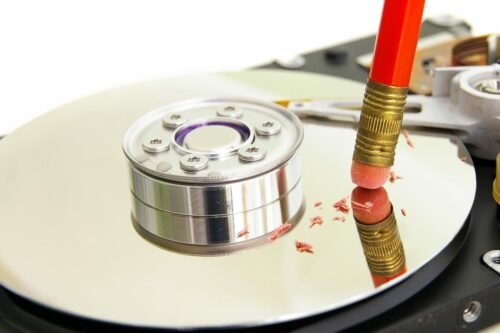SSDs have a long lifespan, but that does not mean they can not fail. How can you recover lost data? It's possible;

When solid-state drives (SSDs) first hit the market, they were warmly received for their speed and reliability. The users they assumed that because an SSD has no mechanical parts, it is less likely to suffer mechanical failure.
And up to a point they are right. Generally an SSD will last longer and perform better better for a long time, especially as the technology becomes more affordable and with more storage space.
But that does not mean that your SSD will not fail at some point. And when that happens, how can you recover your data? And can you really get them back?
Why do SSDs fail?

On an SSD you do not have to worry about the wear and tear of the unit's mechanical components over time. This is simply because there is no moving record arm or rotating disk, as in a traditional hard disk.
However, this does not mean that your SSD will not be damaged. It will suffer, only it will not be mechanical but of another kind. The capacitors degrade over time, the power supply may exceed some limits and the controller chip could fail. So while an SSD is more reliable than a mechanical hard drive, it has components that can and will break down.
Read: How hard drives and ssd die in time
Solid State Drive wear rates
There are three common metrics used to describe SSD wear rates that manufacturers test SSD extensively before releasing it to consumers. The three specifications are:
- P / E Cycles: A program-erase cycle is a process where data is written to an SSD, erased and rewritten. The whole process counts as a cycle. The number of cycles an SSD can withstand depends on the manufacturer, hardware and SSD technology. Total I / O cycles can range from 500 to as high as about 100.000.
- TBW: The Terabytes Written metric describes how much data you can write to an SSD before it fails. For example, a 860GB Samsung 250 EVO SSD is rated at 150 TBW, while the 1 TB model is rated at 600 TBW. Like P/E Cycles, the ratings vary between manufacturers and SSD technology.
- MTBF: Measurement of Time Between Failures is the third SSD reliability measure you will see. The MTBF describes the reliability of the SSD during its life expectancy under normal operation and is usually measured in tens of thousands of hours.
SSDs are made for longevity. You should expect your SSD to last you a long time. Even better, there are not many things that can damage your SSD. Overvoltage is something that can damage your SSD or erase your data, but you can protect yourself from it with an ups or even an electrical outlet or power strip.
However, it is a fact that as your SSD gets older, the electronic components wear out and eventually fail.
Relevant: Measure your disk speed in Windows 11/10
You can recover data from a failed drive disk solid state?
An SSD often does not warn much before it fails. Electronic components do not start buzzing or making noise as they age. They work and at some point they die suddenly. And when an SSD dies suddenly, the news is bad.
When SSDs first came on the market, data recovery experts were unsure if they could recover data the same way they would with a regular hard drive. For many years, however, data recovery software has now fully covered SSDs.
Many home-based data recovery tools, such as EaseUS, Stellar Data Recovery, Disk Drill, and Recoverit, offer a specific SSD data recovery option or standalone tool. Data recovery from an SSD is quite possible.
The only question is how effective it is. The ability to recover data to an SSD is prevented due to the way an SSD manages data corruption on its own using the TRIM command. In addition, the probability of data recovery depends on the condition of the SSD. Is it completely broken or did you lose data in an increase in power?
How does SSD TRIM affect data recovery?
To understand how TRIM affects data recovery, it is helpful to understand what happens when you delete a file on your computer.
Delete data on hard disk

A traditional hard disk stores files in physical locations on a magnetic disk. The operating system indexes the locations of the files and accesses the data using a mechanical arm. In contrast to a solid state drive that is a form of flash memory, such as a USB stick, but with a much larger capacity.
When you click Delete, the file is not actually erased from the magnetic disk. If you have Windows then it moves to the Recycle Bin, where its indexed location keeps pointing to it, in case you want to reset it. When you delete it from the Recycle Bin (or use the shortcut Shift + Delete for immediate deletion), Windows completely removes the file and notifies the operating system that the space is available for new data.
Although this may seem a bit complicated, it does mean that your data will be recoverable, at least for a short time. Because even though the index no longer has the deleted file in its memory, the file still exists in its physical location, until at least someone else is written above it.
Delete data on SSD

Your SSD is different from a regular hard drive due to its data storage technology. Your SSD stores data in cells. Before writing new data to a cell, the SSD must move the existing data to another location on the SSD.
During normal operation, SSDs virtually wipe the data contained in the cells faster, long before they rewrite data in those cells.
SSDs maintain control over where data is stored inside cells. This means that the operating system can request to write data to block 1.000, while the SSD index table contains a completely different number. This is known as wear leveling.
The SSD manages the data location, ensuring that there is room to write new data to the drive. However, although the operating system may mark a block as empty according to its files, the SSD "does its own thing" and moves the data to ensure even wear.
That's where the TRIM command comes in. TRIM allows the operating system to tell the SSD which block it can reset. This process keeps the data entry process fast, as you do not have to wait for the block to reset.
The other side of this utility is that you do not know when the TRIM command will inform the operating system about the blocks that will be reset.
How to detect a failed SSD and save your data
The best way to stop a catastrophic data loss from your SSD is to understand the warning signs. Your old spinning hard drive did sounds like metal bangs, or gurgling weirdly etc before finally hitting and dying. But your SSD doesn't give these audible warning signs.
Read: Five warning signs that the SSD will break
There are many basic warning signs that your SSD is about to die:
- Bad block errors: You can not write to a specific block on the SSD, accidental freezes and errors.
- Refusal to write to disk: Suddenly you can no longer write to the SSD, which in turn causes errors, and more.
- File system repair: You need to repair your operating system on an increasingly regular basis.
- Boot errors: Your operating system could not boot properly and your system failed to load.
- Read only: The SSD suddenly switches to read-only mode, preventing you from writing new data to the drive.
These are not the only indicators before an SSD failure, but they are the most common. A proper backup system should be part of every user's daily routine. You never know when bad things may happen to you, and you'll hit your head against the wall if you lose your important personal data.
Check the health of your SSD

You can also check the health of your SSD by making sure there is no damage or data loss in the next boot process. Windows users may want to try it out CrystalDiskMark, macOS users can take a look at Smart Reporter Lite and Linux users should check smartmontools.
Read: Find out how much damage your SSD drive has to Windows 10
What to do if your SSD fails
If you take care of your SSD, use monitoring tools to check the health of the drive and also buy a surge protector, you have the opportunity to avoid a catastrophic mistake on your SSD.
But you can't catch all the bugs. However, you will have a good line of defense through audits and constant monitoring. However, suddenly your SSD disk has failed. What can you do to recover your data?
The key is to act immediately because as we said before the operating system can delete your lost data without warning. So you should immediately shut down your computer and remove your disc from your machine and try to see it as an external drive from another machine.
If you can see the disc
Be careful if you manage to see it, under no circumstances should you write anything on it. Immediately copy any files you don't want to lose and make sure they open and work. There's a chance you've copied a photo file, for example, but when you try to view it it's not accessible.
If you can not see him
Use a data recovery program, as you would with a hard drive. Programs like Wise data recovery, Lazesoft Recovery Suite Home Edition, Windows File Recovery, EASEUS Data Recovery Wizard, and many more, now support SSDs.
You may need to experiment a lot with different recovery programs. If in the end you do not manage to get your lost data, there is a solution to give your disk to a specialist to do the job for you.
Recover deleted files
If the disk is not corrupted but you only want to restore a file that you deleted from the Recycle Bin, then stop any recording and use one of the above programs to read deleted files.
If you have not already installed such a program on your computer, do not do it right away because installing it can completely delete the deleted files you are looking for. Prefer to run the data recovery program from a usb stick.





